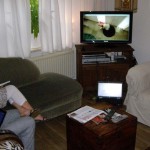M11 Master Project by Nick Sturkenboom. [PDF, 1.5M]

In the EU, policy makers have been debating over carbon reduction for many years. One of the methods that pursue to reduce our carbon footprints is to raise energy awareness and stimulate energy efficiency through behavioral and attitude change. However, these same policy makers currently overlook the reasons why people consume resources, how these ‘needs’ and ‘wants’ establish themselves and evolve over time in our everyday lives, also known as ‘practices. (E.g.) (Shove E. , 2003) (Hargreaves, 2011) (Chetty, 2008) (Stern, 2000) (Hertwich, 2005)
According to Shove, ‘practices are defined as a coordinated entity of inter-related and mutually reinforcing ‘components’ (Shove E. M., 2008) In simpler words, a practice is a system of doing, existing out of 3 elements: conventions, materials and competences which are deeply embedded within society, rendering them to appear ‘normal’ and are therefore easily to be overlooked.
Practices are particularly interesting to designers as we configure the material infrastructures through our designs while proposing new ways of doings, often resulting in new needs and desires. It is important for sustainability to research this area as technological efficiency improvements may result in unintended outcomes that are often for the worse. (Scott, 2009)
SOFIA is a software platform that enables devices to become inter-connectable and exchange information from the ‘Web’ (Internet of Things), opening an up a whole new range of (multimedia) applications and control within the household. Revolutions in technological infrastructures like SOFIA are seen as an opportunity to transform our practices into more sustainable ones. (Wilson, 2007) Therefore a study was initiated into a practice that is rising to be one of the biggest electric consumers within the household, the television. (Department for Energy and Climate Change, 2010 (July)) (Ministerie van Economische zaken, 2008)
During this project a service was designed that aims to diminish energy consumption while supporting the practices that are embedded within the use of television. One of its features, dimming the backlight of a television when none is actively looking at the screen, was tested against users in a household setting to see whether subjects would notice the dimming effect and if so, how much of a negative impact it has on their viewing experience.
FULLTEXT: PDF